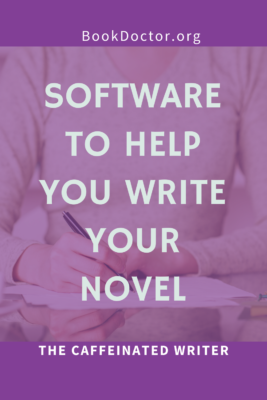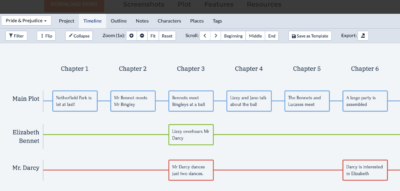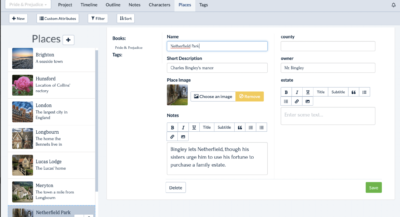Great software to help you write, revise, and publish your novel

Nabokov’s wife Vera did all the driving and typing. Dostoevsky proposed to his stenographer, Anna, after she took his novel The Gamblers down in shorthand and then converted it to tidy prose. Sophia Tolstoy copied War and Peace out by hand seven times. If you don’t have a doting wife to cheerfully take dictation, correct your errors, bring you coffee, haul you back on the wagon when you fall off of it, and chauffeur you to fabulous literary parties, you’ll need to do the heavy lifting yourself. In this post, we’ll take a look at the best software for writing a novel.
Get your free novel planning worksheets.
Do you need special novel-writing software to compose your novels? Absolutely not. Word will do, and has done, for many writers for many years. I still use Word pretty much every day for one writing task or another. That said, novel-writing software can help you streamline the process and make the best of your novel’s many moving parts.
I’ve written five novels (six if you count the novel-in-progress, seven if you count the 18-year-old novel-in-a-drawer), and I’ve used Word for all of them, in addition to Scrivener for the last three. Now I’m exploring the intuitive outlining software Plottr and the Cadillac of screenwriting software, Final Draft. Let’s break it down.

If you want a simple, clear, highly visual way to outline your novel, you can’t go wrong with Plottr. New to the writing software game, Plottr’s beauty is in its simplicity. By moving colored boxes around on a timeline, you can easily insert scenes, chapters, and characters. Plottr has a number of quick, free video tutorials, but you probably won’t even need to watch them to get started.
Here’s a Screenshot from Plottr’s demo outline of Pride and Prejudice.

If you like visualizing your locations, you’ll love the settings feature in Plottr (screenshot below). There’s also a similar feature for characters, and a terrific, intuitive setup for scene cards, notes, and more.

At just $47 per year for unlimited use on three devices or $67 per year for unlimited use on six devices, it’s also the most affordable novel-writing software I’ve found.
Note that Plottr does just one thing–outlining–but it does it extremely well. For a streamlined process that allows your novel to grow and mutate (as all great novels do), I recommend using Plottr with Scrivener.
Get Plottr
Scrivener – an essential tool for writing your novel
These days, I use Scrivener to compose my novels. It’s especially useful if you write in a non-linear fashion, because Scrivener makes it easy to move chapters around and visualize your novel. It also helps you to understand and manage narrative patterns. Let’s say you want your subplot to come back every six chapters; you can easily manage that in the Scrivener manuscript view as well as on color-coded notecards. Project targets allow you to easily see how much you’ve written each day and how far you have progressed toward your goal.
My favorite feature of Scrivener is the digital corkboard that automatically generates index cards as you add scenes and chapters. When you move the index cards around on your corkboard, it also moves the scenes within your manuscript. I also love writing in Scrivener’s Focus mode, because Vera hasn’t cleaned up my desktop in like, ever, and there are so many folders on top of screenshots on top of apps on top of notes that writing with icons in view stresses me out.
Verdict: Scrivener has a ton of features that I don’t use, and you could get lost in the funhouse with all their training videos, but the color-coded corkboard, flexibility, project targets, and minor price tag ($49) make it a no-brainer for me.
Get Scrivener (includes a free trial)
Final Draft – the industry-approved tool for screenwriters
I bought the screenwriting software Final Draft a few years ago because I had this idea I was going to take a screenwriting class. I recently updated to Final Draft 11 because they added new bells and whistles, and I love bells and whistles, and I still keep thinking maybe I’ll take a screenwriting class. At this point I’m just experimeting with it, should I decide to adapt one of my own novels in the future. The Beat Board feature is fun, and you can color code everything — from characters to settings to tags — but because it is designed for screenwriting the communication between the corkboard and the script itself isn’t as intuitive as Scrivener from a novelist’s perspective.
I do like the dictation feature in Final Draft. I must have some lingering remnants of my Alabama accent, because some words come out a little off target, but it’s still surprisingly accurate. I don’t use dictation for writing, because something happens between the brain and the fingers that doesn’t happen between the brain and the mouth, but dictation can be handy for writing notes to myself in the script.
Verdict: Final Draft is a must for screenwriters and a fun, if pricey, playground for novelists at $249. I’d love for someone from Final Draft to come around and show me that FD11 is my new best friend, but for now, it feels too complicated to use for everyday novel writing.
Vellum – the best software for publishing your novel
If you want to self-publish anything, ever, you need Vellum. Period.
Here are a few things I like about Vellum:
- The software works equally well for fiction and nonfiction.
- There are several templates, from traditional to modern, that allow you to easily give your book a look that fits your content.
- You can easily scroll between templates to see how your book looks in each design.
- You can easily scroll between views of Kindle, iPad, desktop, Android, iphone, and print versions of your book.
- Inserting links for Amazon, Bookshop.org, other retailers, and your own website is super-quick and easy.
- One-click formatting allows you to create beautiful block quotes, drop caps, and other elements.
- The Table of Comments is automatically generated.
- Creating a beautiful copyright page, title page, epilogue, endnotes, author page, and other professional-looking pages is incredibly simple.
- Your one-time purchase of a $199 license allows you to create unlimited ebooks.
See my full review of Vellum, or simply try Vellum yourself. (You’ll be hooked, I promise).
Word
Word remains an excellent, basic tool, especially if you like to keep all of your writing in a single document and just pick up where you left off each day. If you’re using Word, you might like How to Organize Your Novel in Word.
Verdict: Although life without Word would be discombobulating, Word is pretty bare bones when it comes to organizing, so it’s a good idea to supplement it with other software.
Novel writing software roundup
That’s it!
- You probably already have Word.
- Outline your novel with Plottr: Get Plottr for $47.
- Whether you’re a plotter or a panther, you can do pretty much everything with Scrivener. Get Scrivener here for $59.
- At $249, Final Draft 11 is excellent for screenwriters, but probably not worth the expense for novelists unless you decide to adapt your own novel.
- Vellum is essential software for anyone who wants to publish books independently. Whether you’re publishing one book or ten, you’ll save yourself a lot of time, headache, and money with a Vellum license.
That’s all… happy writing!
Michelle Richmond is the internationally bestselling author of six novels, including The Marriage Pact. She helps writers complete their novels in the transformational course Novel in Nine.
Get your free novel planning worksheets & receive The Caffeinated Writer in your inbox two to three times per month when you subscribe to The Caffeinated Writer on Substack.